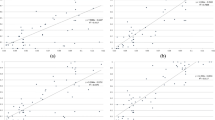Abstract
Linkage disequilibrium (LD)-based methods capitalize on the number of generations that occurred since the appearance of a mutation at a QTL and can produce extremely accurate estimates of the QTL position. Here, we describe a regression methodology to estimate the effect of marker haplotypes on a quantitative trait for the case of inbred plant populations. The method builds upon probabilities of being 'Identical by Descent' that are obtained via a gene-dropping simulation, where inbreeding is assumed to be due to a single seed descent process. The method was empirically tested via Monte Carlo simulation and results showed that the power to detect the true QTL position depended on the age of the QTL mutation, effective population size and marker distances. Also, increased marker polymorphism dramatically improved power and the method seemed fairly robust to differences in genetic and population assumptions.
Similar content being viewed by others
References
Bulmer, M.G., 1985. The Mathematical Theory of Quantitative Genetics. Clarendon Press, Oxford.
Hastbacka, J., A. De La Chapelle, I. Kaitila, P. Sistonen, A. Waever, et al., 1994. Linkage disequilibrium mapping in isolated founder populations: Diastrophic dysplasia in Finland. Nat Genet 2: 204–211.
Hudson, R.R., 1993. The how and why of generating gene genealogies. In: N. Takahata & A.G. Clarck (Eds.), Mechanics of Molecular Evolution, pp. 23–36, Sinauer Sunderland MA.
MacCluer, J.W., J.L. Vandeberg, B. Read & O.A. Ryder, 1986. Pedi-gree analysis by computer simulation. Zoo Biol 5: 147–160.
Meuwissen, T.H.E. & M.E. Goddard, 2000. Fine mapping of quantitative trait loci using linkage disequilibrium with closely linked marker loci. Genetics 155: 421–430.
Meuwissen, T.H.E. & M.E. Goddard, 2001. Prediction of identity by descent probabilities from marker haplotypes. Genet Sel Evol 33: 605–634.
Patterson, H.D. & R. Thompson, 1971. Recovery of inter-block information when block sizes are equal. Biometrika 58: 545–554.
Winkler, C.R., N.M. Jensen, M. Cooper, D.W. Podlich & O.S. Smith, 2003. On the determination of recombination rates in intermated recombinant inbred populations. Genetics 164: 741–745.
Author information
Authors and Affiliations
Rights and permissions
About this article
Cite this article
Bink, M.(., Meuwissen, T.(. Fine mapping of quantitative trait loci using linkage disequilibrium in inbred plant populations. Euphytica 137, 95–99 (2004). https://doi.org/10.1023/B:EUPH.0000040506.58721.66
Issue Date:
DOI: https://doi.org/10.1023/B:EUPH.0000040506.58721.66




